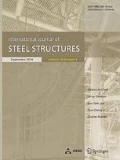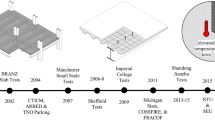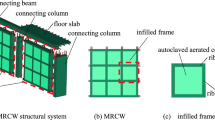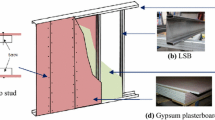Abstract
A novel hybrid floor, which was a prefabricated composite system infilled using polymers with hollow cores between its top and bottom steel plates, was previously developed for application in steel structures. In addition, the structural performance of the steel floor, including its bending capacity, floor vibration, and dynamic characteristics, were investigated. However, as the fire resistance performance of the hybrid floor had not been investigated, it was installed in actual buildings using insulating materials, which caused problems, such as a dirty workplace and additional work that prolonged the construction period. In this study, small-scale furnace tests, whose specimens have fewer variables in comparison with those of full-scale tests, were conducted instead of full-scale furnace tests to analyze the effects of various variables on the fire resistance performance of the hybrid floor. In fact, the heating curves obtained via the small-scale furnace tests were not similar those suggested by Korean Standards (KS). The energy-based time equivalent approach was applied to calibrate the results. Thus, the fire resistance ratings were estimated based on small-scale furnace tests via the energy-based time equivalent approach with respect to polymer thickness and aspect ratio, which were expressed using the lengths and widths of the specimens.














Similar content being viewed by others
References
Awad, Z. K., Aravinthan, T., Zhuge, Y., & Manalo, A. (2013). Geometry and restraint effects on the bending behaviour of the glass fibre reinforced polymer sandwich slabs under point load. Materials and Design, 45, 125–134.
Bailey, C. G. (2001). Membrane action of unrestrained lightly reinforced concrete slabs at large displacements. Engineering Structures, 23(5), 470–483.
Bailey, C. G., Toh, W. S., & Chan, B. M. (2008). Simplified and advanced analysis of membrane action of concrete slabs. ACI Structural Journal, 105(1), 30.
Bischoff, P. H., & Scanlon, A. (2009). Span-depth ratios for one-way members based on ACI 318 deflection limits. ACI Structural Journal, 106(5), 617.
Buchanan, A. H., & Abu, A. K. (2017). Structural design for fire safety. Chichester: Wiley.
Gilbert, R. I. (1985). Deflection control of slabs using allowable span to depth ratios. ACI Journal, 82(1), 67.
Kim, Y. Y. (2016). Flexural Capacity of Nano-Composite Infilled iFLASH System. M.S. Dissertation, Korea University, Seoul (in Korean).
Kodur, V. K. R., Pakala, P., & Dwaikat, M. B. (2010). Energy based time equivalent approach for evaluating fire resistance of reinforced concrete beams. Fire Safety Journal, 45(4), 211–220.
KS F 2257-1. (2014). Methods of fire resistance tests for elements of building construction – General requirements. Seoul, Korea: Korean Standard Association. (in Korean).
KS F 2257-5. (2014). Methods of fire resistance tests for elements of building construction – Specific requirements for loadbearing horizontal separating elements. Seoul, Korea: Korean Standard Association. (in Korean).
Lee, J. H., Lim, D. S., Ju, Y. K., & Yoon, S. W. (2016). Vibration Characteristics of iFLASH System. Journal of the Korean Association for Spatial Structures, 16(3), 89–97.
Pakala, P. (2009). Energy based equivalent approach for evaluating fire resistance of reinforced concrete beams. Michigan State University.
Park, M. J., Min, J. K., Bae, J., & Ju, Y. K. (2020). Thermal contact conductance based thermal behavior analytical model for hybrid floor at elevated temperature. Materials (in review).
Ryu, J. H., Ju, Y. K., & Yoon, S. W. (2014). Dynamic characteristic of composite beam using the sandwich plate system. Journal of the Korean Association for Spatial Structures, 14(4), 65–72.
Ryu, J., Kim, Y. Y., Park, M. W., Yoon, S. W., Lee, C. H., & Ju, Y. K. (2018). Experimental and numerical investigations of steel-polymer hybrid floor panels subjected to three-point bending. Engineering Structures, 175, 467–482.
Tian, Y. (2019). Thermal Characteristics of PCM Infilled Hollow Hybrid Floor. M.S. Dissertation, Korea University, Seoul.
Acknowledgements
This research was financially supported by the National Research Foundation of Korea (NRF-2017R1A2B3006531 and NRF-2018R1A4A1026027) and by grants (20AUDP-B100343-06 and 20AUDP-B121747-05) from the Architecture & Urban Development Research Program funded by the Ministry of Land, Infrastructure, and Transport of the Korean government. The authors are grateful to the authorities for their supports.
Author information
Authors and Affiliations
Corresponding author
Additional information
Publisher's Note
Springer Nature remains neutral with regard to jurisdictional claims in published maps and institutional affiliations.
Rights and permissions
About this article
Cite this article
Park, M., Bae, J., Ryu, J. et al. Fire Resistance of Hybrid Floor Based on Small-Scale Furnace Tests and Energy-Based Time Equivalent Approach. Int J Steel Struct 20, 1811–1821 (2020). https://doi.org/10.1007/s13296-020-00353-1
Received:
Accepted:
Published:
Issue Date:
DOI: https://doi.org/10.1007/s13296-020-00353-1




